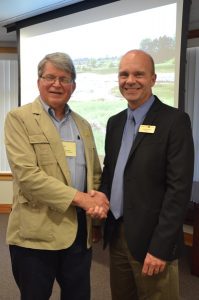NIC will sign a Memorandum of Understanding June 4 with Comox Valley Project Watershed to restore the estuary environment and research new guidelines for blue carbon research in B.C.

Comox Valley Project Watershed Board Chair Paul Horgen and NIC President John Bowman sign a Memorandum of Understanding agreeing to work together to restore the K’ómoks Estuary and research new guidelines for blue carbon research in B.C.
“NIC students are bringing science to life – mapping eelgrass, improving estuaries and creating positive change in their own community,” said NIC Science Department Chair Christine Hodgson, who is also a Project Watershed member.
Blue carbon is carbon captured by salt marsh grasses, eelgrass and other aquatic plants.
The grasses provide critical fish habitat, storm surge protection, and value for shellfish operations. They also absorb carbon up to 100 times faster and more permanently than terrestrial forests – making their habitat crucial to understanding and reducing CO2 levels in the atmosphere.
Project Watershed is the leader in blue carbon research in the K’ómoks Estuary. It researches, plants, and maps eelgrass and salt marsh grasses. In 2014, it received federal recognition and a $230,000 grant from an international research institute on climate solutions, as well as a $10,000 provincial grant to hire a student summer intern.
The agreement could create a protocol for other coastal communities interested in restoring their own estuaries and support the creation of blue carbon greenhouse gas offsets under the B.C. offsets system.
“There are many opportunities for the public and communities to get involved by planting intertidal eelgrass and restoring the shoreline with us,” said Paul Horgen, the Chair of the Board of Directors for the Comox Valley Project Watershed Society.
In conjunction with NIC’s Centre for Applied Research, Technology and Innovation, Hodgson received a $25,000 Natural Sciences and Engineering Research Council of Canada (NSERC) grant to map the distribution of eelgrass relative to Shellfish Aquaculture sites, and monitor habitat with NIC students, the K’ómoks First Nation, Pentlatch Seafoods and Comox Valley Project Watershed.

NIC student Jamie Lund hands the GoPro camera to a KFN student while documenting eelgrass beds in the K’ómoks Estuary. Photo: Island Life Photographics
NIC student Jamie Lund’s research into the distribution of eelgrass beds near the Royston Wrecks involved Project Watershed and a group of K’ómoks First Nation students. Her work, as well as Beatrice Proudfoot’s digital estuary maps, were presented at a Project Watershed Conference in the Comox Valley in March.
For more information on applied research at NIC visit: www.nic.bc.ca/CARTI.

